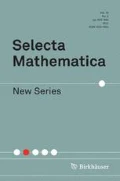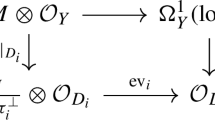Abstract
We develop the theory of singular support for étale sheaves on algebraic varieties over an arbitrary base field.
Similar content being viewed by others
Notes
The terminology of [5] 5.4.12 is “h is non-characteristic for C.”
Here is a simple proof of this fact due to Kuznetsov: By Theorem 1.3(ii) it is enough to prove that \(SS({\mathcal {F}})\) is isotropic. We use induction by \(\dim Y\) where Y is the support of \({\mathcal {F}}\). By Hironaka one finds a proper map. \(r : Z\rightarrow X\) and a dense open \(V \subset Y\) such that Z is smooth, \(r (Z)=Y\), \( r^{-1}(V) \buildrel \sim \over \rightarrow V\) (so we have the embedding \(j : V \hookrightarrow Z\)), \(D:=Z\smallsetminus V\) is a divisor with normal crossings in Z, and \({\mathcal {F}}|_V\) is locally constant. The cone \({\mathcal {G}}\) of the canonical map \({\mathcal {F}} \rightarrow r_* j_* ({\mathcal {F}} |_V )\) is supported on \(Y\smallsetminus V\), so \(SS({\mathcal {G}})\) is isotropic by the induction assumption. Since \(SS({\mathcal {F}} )\subset SS({\mathcal {G}}) \cup SS (r_* j_* ({\mathcal {F}} |_V ))\), it remains to show that \(SS(r_* j_* ({\mathcal {F}} |_V ))\) is isotropic. Now \(SS( j_* ({\mathcal {F}} |_V ))\) is isotropic: indeed, it is the union of the zero section and of the conormals to intersections of the components of D (use 2.2(ii) applied to a local covering of Z ramified at D on which \({\mathcal {F}} |_V \) trivializes to reduce the assertion to the case of constant \({\mathcal {F}}\), then use 1.4(ii)). We are done since \(SS(r_* j_* ({\mathcal {F}} |_V ))\subset r_\circ SS(j_* ({\mathcal {F}} |_V ))\) (see 2.2(ii)) and \(r_\circ \) sends isotropic cones to isotropic cones.
Deligne shows that every C that is not a conormal can be identified étale locally at the generic point with one of \(C_n\)’s from the next example.
Proof The map \(r_n\) is finite, so \(SS({{\mathcal {F}}}_n )\subset r_{n\circ } SS (\mathbb {Z}/\ell _V)\) by 2.2(ii). Since \(SS(\mathbb {Z}/\ell _V)\) is the zero section of \(T^* V\) (see 2.1(iii)) and \(r_n\) is étale over the complement to the x-axis, an immediate computation shows that \(r_{n\circ } SS (\mathbb {Z}/\ell _V )\) is the union of \(C_n\) and the zero section of \(T^* V\). Now \(SS({{\mathcal {F}}}_n )\) contains the zero section of \(T^* V\) since \({{\mathcal {F}}}_n\) is nonzero at the generic point of V, and \(SS({{\mathcal {F}}}_n )\) is not equal to the zero section at the generic point \(\eta _x\) of the x-axis since \({{\mathcal {F}}}_n\) is not locally constant there (use 2.1(iii)). We are done since every closed subcone of \(C_n\) other than \(C_n\) is contained in the zero section at \(\eta _x\).
I.e., \(\{ {{\mathcal {F}}}_\alpha \}\) are irreducible perverse sheaves that can be realized as subquotients of some perverse sheaf cohomology \({}^p {{\mathcal {H}}}^a {{\mathcal {F}}}\).
To check that \(C_1 ,C_2 \in {{\mathcal {C}}}' ({{\mathcal {F}}})\) implies \(C_1 \cap C_2 \in {{\mathcal {C}}}' ({{\mathcal {F}}})\) notice that if a test pair (h, f) as in 1.1 with \(\dim Y=1\) is \(C_1 \cap C_2\)-transversal, then locally on U it is either \(C_1\)- or \(C_2\)-transversal. The latter assertion need not be true if \(\dim Y>1\) (consider cones \(C_1\), \(C_2\) that are nonzero with zero intersection at the generic point of X and \((h,f)=(\text {id}_X ,\text {id}_X )\)).
With modification as above in case k is finite. Indeed, the modification is needed to ensure that \(SS^w ({{\mathcal {F}}})\) for \({{\mathcal {F}}}\) a skyscraper sheaf at \(x\in X\) equals \(T^*_x X\).
Since we live on a projective space this means that the cohomology sheaves come from Spec\(\, k\).
Theorem 1.3(i) asserts that \({{\mathcal {C}}^{\text {min}}}({{\mathcal {F}}})\) has a single element. But we did not prove it yet.
Use the fact that for any \(\nu \ne 0\) in \(\mathbb {A}^n\), the set \(\{ A(\nu ), A\in \text {Mat}_{n,m-n}(k)\}\) is dense in \(\mathbb {A}^{m-n}\).
Which is always true if the base field k is perfect.
So a geometric point of \(Q^{(a )}_P\) is a collection \((q_1,\ldots , q_a )\) of pairwise distinct geometric points of Q such that \(\pi (q_1 )=\cdots =\pi (q_a )\).
In other words, \(\rho _{(x_1 ,\ldots , x_m )}^{(m)}\) is the restriction map \(\Gamma (\mathbb {P}, {{\mathcal {O}}}(d ))_{\bar{k}} \rightarrow \Gamma (\sqcup x_i^{(1)},{{\mathcal {O}}}(d))\).
We use the fact that on a smooth variety every perverse subquotient of a locally constant perverse sheaf is locally constant.
Notice that this evidently excludes the situation when \(\dim Y_1=\dim Y_2 =0 \).
Here we assume that k is infinite; otherwise \( U\subset \mathbb {P}_{k'}\) for a finite extension \(k'\) of k, see 1.5.
Use the fact that for any subset \(A\subset T^* X\) one has \( \pi ^\circ \overline{A}=\overline{\pi ^\circ A} \) where \(\bar{\,\,}\) means the closure (which follows since \(\pi \) is open and \(d\pi : T^* X\times _X Z \rightarrow T^* Z\) is a closed embedding).
Here U is a neighborhood of x where f is defined.
Inspired by a discussion with Deligne.
I.e., \(\kappa \) vanishes on \(TC_{\text {reg} }\subset T(T^* \mathbb {P} )\).
The parity of the rank does not depend on the choice of \((x,\nu )\in C_{\text {reg}}\): it is odd if and only if \(T_{(x,\nu )}C\) and \(T^v (T^* \mathbb {P})\) lie in the different components of \(\text {Gr}^\kappa (T_{(x,\nu )}(T^* \mathbb {P} ))\).
References
Brylinski, J.-L.: Transformations canoniques, dualité projective, théorie de Lefschetz, transformations de Fourier et sommes trigonométriques. Astérisque 140–141, 3–134 (1986)
Deligne, P.: Théorèmes de finitude en cohomologie \(\ell \)-adique. Cohomologie étale (SGA \(4\frac{1}{2}\)), Lect. Notes in Math. 569, pp. 233–251. Springer, Berlin (1977)
Deligne, P.: Notes sur Euler-Poincaré: brouillon projet. Manuscript (2011)
Deligne, P.: Letter to the author from July 9, 2015
Kashiwara, M., Schapira, P.: Sheaves on Manifolds. Grundlehren der Mathematischen Wissenschaften, vol. 292. Springer, Berlin (1990)
Katz, N.: Pinceaux de Lefschetz: théorème d’existence. Groupes de monodromie en géométrie algébrique (SGA 7 II), Lect. Notes in Math., vol. 340, pp. 212–253. Springer, Berlin (1972)
Saito, T.: The characteristic cycle and the singular support of a constructible sheaf. arXiv:1510.03018 (2015)
Sato, M., Kawai, T., Kashiwara M.: Microfunctions and Pseudo-Differential Equations, Lecture Notes in Math., vol. 287, pp. 265–529. Springer, Berlin (1973)
Author information
Authors and Affiliations
Corresponding author
Additional information
To Joseph Bernstein
The author was supported in part by NSF Grant DMS-1406734.
Rights and permissions
About this article
Cite this article
Beilinson, A. Constructible sheaves are holonomic. Sel. Math. New Ser. 22, 1797–1819 (2016). https://doi.org/10.1007/s00029-016-0260-z
Published:
Issue Date:
DOI: https://doi.org/10.1007/s00029-016-0260-z




